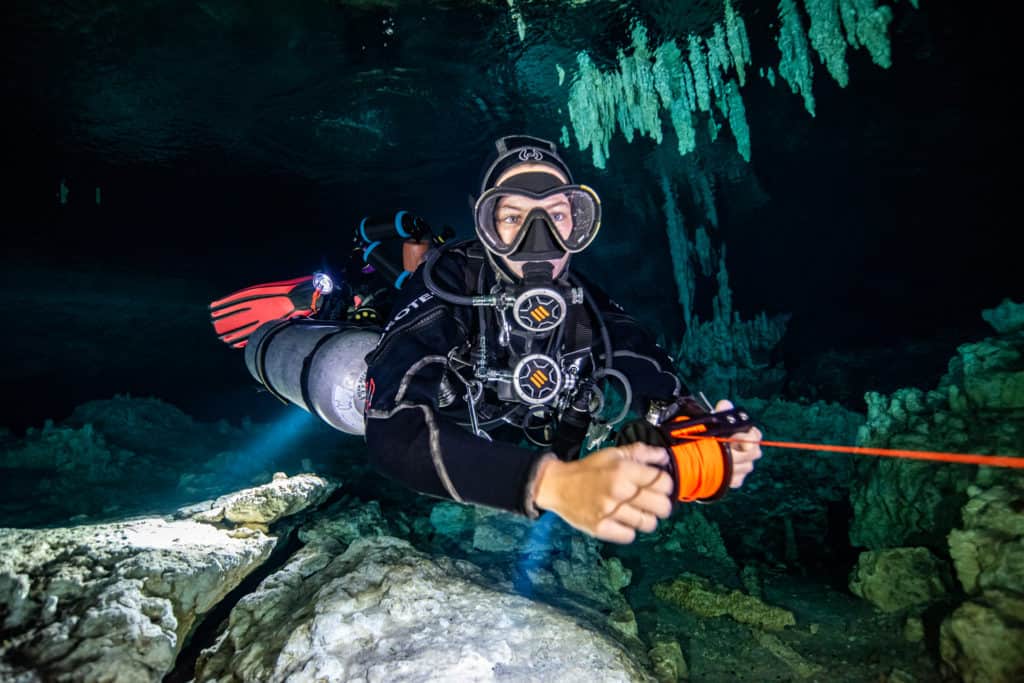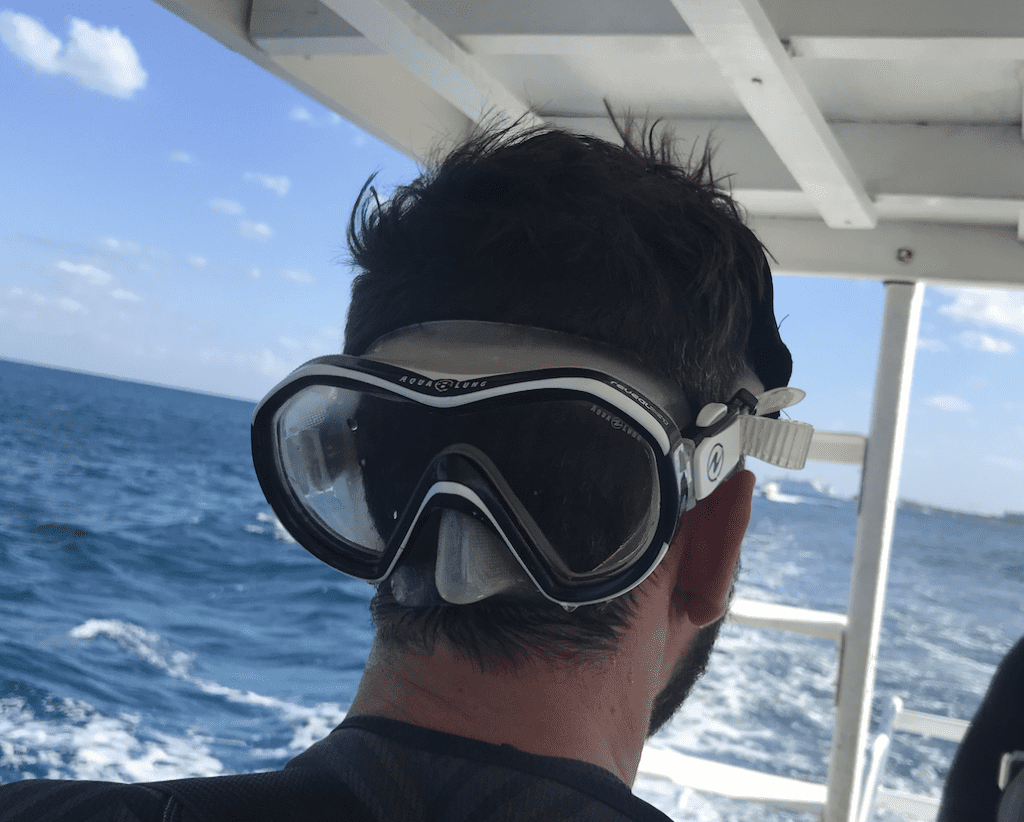There is nothing worse on a dive than needing to clear your mask over and over as it keeps fogging! Find out how to clean your mask and prevent your scuba mask fogging up and spoiling your view.
Stop Your Snorkel Mask from Fogging
The ocean visibility may be clear for meters, but if you have a foggy mask it spoils the great scenery of the coral and marine life, and you may as well be diving in a silted-up riverbed!
Nobody wants to miss a chance turtle sighting because they were too busy clearing their mask for the umpteenth time, so learning how to clean and take care of your dive mask is an important skill for divers to learn.
You’ll also need to know how to clear it underwater for if it does fog up!
We’re going to explain why masks get foggy, how to prepare your mask for a dive, and what to do if you buy a brand new scuba mask.
Why Is My Scuba Mask Fogging Up?
A scuba mask fogs when the water vapor inside it condenses due to a difference in temperature between your warm face, and the cooler water. Condensation fogs a mask when moisture in the mask clings to the glass (like fog on the mirror in your shower).
New Scuba Mask Preparation
When you get a lovely new dive mask from your local dive shop, it’s so exciting to wear it on your next dive in the water. But the likelihood is that it will be foggy for the first few times of use.
This is because new masks have a leftover residue on the lenses from the manufacturing process, which some say is to help prevent the lens from being scratched. This residue needs to be removed before you dive with it, else you’ll find your mask constantly fogging up, no matter how much you clear it.
There are two tried and tested ways to prepare a new scuba mask for diving.
Toothpaste your Dive Mask
You have it easily on hand in your bathroom, and as well as keeping your pearly whites clean, it will also clean off mask residue too!
It’s best to use the most basic white toothpaste you can find, without the gels or whitening crystals.
Squirt out some toothpaste on your scuba mask and rub it around the inside of the lens for a few minutes using either your finger or a soft, non-abrasive cloth.
Leave it overnight to work, and rinse in fresh water.
You may need to do the toothpaste trick a few times for it to work successfully.
Burn your Scuba Mask
A seemingly more extreme option, but with better results is to use a flame, either from a long tapered candle, or a lighter, to burn away the residue that causes fog.
I know what you’re thinking – I’ve just bought a beautiful new mask and you want me to burn it?! But trust me, it’s a trick used by divers across the globe.
Run the tip of the flame over the inside of the lenses, making the glass turn black as the sooty residue burns away. Let it cool, and then wipe the black soot away using a soft cloth. Repeat the process a few times until you notice that the glass is more difficult to turn black.
Be careful when employing this technique, as the glass can get very hot and can damage the mask. Keep the flame away from the soft silicone mask skirts, and do not try this on masks with plastic lenses.

Best Mask Defogger
Before every dive, you should still use a defogging liquid to prevent fogging from occurring. This prevents any condensation that will occur from forming on the glass of the mask and spoiling your view of the reef.
There are a few different defoggers you can use, but with all of these methods, the premise is to leave a layer of defog liquid on the mask lens as you enter the water, so it is important not to touch the lens before you dive.
Scuba Mask Defog Spray
There are several options of defogging spray available to purchase at dive stores and online. With a spray like this, you spritz in a little bit and wipe it around the inside of the lens using your finger. Then rinse it off with a little fresh water.
The idea is to have a thin layer of the defog spray on the lens as you dive, so rinse it out carefully, and don’t rub the defog out as you clear it.
Saliva
Often people (non-divers!) wonder ‘Why do divers spit in their mask?’ and the simple answer is – it’s a free defog!
You never need to worry about packing it, you’ll never run out, and it’s eco-friendly (just be sure to only defog your own mask to avoid spreading germs!)
As with the commercial defog liquid, spit inside and rub it around with your finger, and then rinse briefly in fresh water. Do this one immediately before a dive, as it works best with the saliva layer still moist as you wear it.
Baby Shampoo Anti Fog
The ‘no more tears’ branding is a divers savior as well as for little ones! Baby shampoo can be used as a defogging liquid too. Simply water down the shampoo (any mix between 1 part soap and 5-10 parts water seems to work well) and apply it to the inside of the mask predive.
As it’s baby shampoo, it’s kinder on your eyes, is hypo-allergenic, and it also smells deliciously fresh too!
Dish Soap for Defogging
Often you’ll find that dive boats carry a diluted dish soap liquid for divers to use as a defog agent. This follows the same principle as the baby shampoo-style liquid soap, but has a side effect, that it can sting and burn your eyes!
Be aware that this also isn’t biodegradable and too much can have a negative effect on the reef, so try not to get it in the ocean.
Other Tips for Defogging Snorkel Masks
Dry Face and Hands
Always put your mask onto a clean dry face. Having a layer of sunscreen or moisturizer on your face will contribute to fogging on your dive. Wipe your face (and hands) using a dry towel before applying the defog liquid and putting the mask on.
Once on your face, try not to fiddle with the mask too much.
Keep Your Scuba Mask Around your Neck
Between dives, or as they are gearing up, you often see divers with their masks on their forehead, ready to pull on as they prepare to enter the water. Now it may seem like a sensible place to keep it, so that it’s close by as you gear up, but being on your hot, sweaty forehead will make it hotter and scuba mask fogging more likely.
It’s best to keep your mask around your neck during your pre-dive check (or in fact, any time you remove your mask, as you’re also less likely to lose it!)

Breathe Through Your Mouth
As you breathe in and out through your regulator when diving, this should be apparent, but some divers still manage to breathe out through their nose (and not just when clearing their mask).
Like breathing onto a window, the warm air that exhales from your nose will create condensation, and in turn a foggy mask.
Get A Dive Mask That Fits Properly!
One of the most important factors to getting the perfect mask that doesn’t fog up is having one that fits properly!
When buying a new scuba mask it’s important to try it on at your local dive shop to make sure it fits your face perfectly and creates a seal that doesn’t leak water around your face.
One of the best ways to test a mask fits properly is to place the mask skirt against your face, without putting the strap around your face. Look down at the ground and inhale through your nose.
If it stays securely against your face, then you’ve found a mask that fits! If it makes any gaps or doesn’t stay on your face, you need to try a mask that’s another style or shape.
After Dive Mask Care
After every dive trip, you should rinse your mask carefully. Always be careful when cleaning your scuba mask, and only use a soft dry cloth to clean the lenses. Drying your mask well too will also prevent the build-up of mold that can form around the skirting of your mask.
Consider storing your mask in a cushioned mask box to keep it free of dust and safe from potential scratches.
Stopping Scuba Mask Fogging
Hopefully, if you follow these tips, you’ll have a great view during every single dive! Remember, with newer masks, you may need to repeat the burning or toothpasting several times until your mask stays clear.
We can’t wait to take you (and your scuba mask) on a dive with us in the Riviera Maya soon. Whether we explore the cenotes, the reefs of Playa del Carmen, or the ever-popular Cozumel, there’s always something worth seeing – without any scuba mask fogging!
We hope you liked this blog post on ‘How to defog a snorkel mask’.
If you enjoyed reading, make sure to read our other blog topics, leave us a comment, or follow us on our Facebook & Instagram pages!


